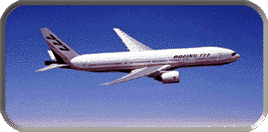
 |
   |

Boeing launched the 777 program in 1990 and actively
sought input from a number of major carriers on how
this, the world's largest twin-jet, would be designed.
Thus, the 777 is particularly responsive to market
needs and customer preferences. In 1995, the 777
first entered service with United Airlines (one of the
carriers which actively participated in the aircraft's
development) after being the first aircraft to gain FAA
approval for 180 minute extended-range twin-engine
operation upon service entry. The initial model, the
777-200, has since been enlarged to create the 777-300
and modified to create the increased gross weight
777-200 (IGW, longer-range model).
William E. Boeing produced his fist two B&Ws (a single-
engine seaplane) in 1916 and the following year, the
U.S. Navy ordered 50 of Boeings next model (the two-
seat model C trainer)to serve in in World War I.
Boeing continued to make airplanes, both commercial and
military, producing such famous models as the Pan
American "Clipper" flying boat and the "Stratoliner"
(first pressurized cabin). In World War II, Boeing
became an integral part of the allied effort by
building the B-17 and B29 bombers. In the post-war era,
Boeing continued making military aircraft such as the
B-47 and B-52 bombers but also recognized the huge
market for commercial jet aircraft and thus developed
the 707 which would help revolutionize air travel.
Today, with jets in operation for carriers in 120
different countries, Boeing is best known as the
world's largest manufacturer of commercial aircraft.
The Boeing company is headquartered in Chicago, Illinois
and employs approximately 120,000 people.
In recent years, Boeing has consistently been one of
the top three exporters in the United States.
|
|
|